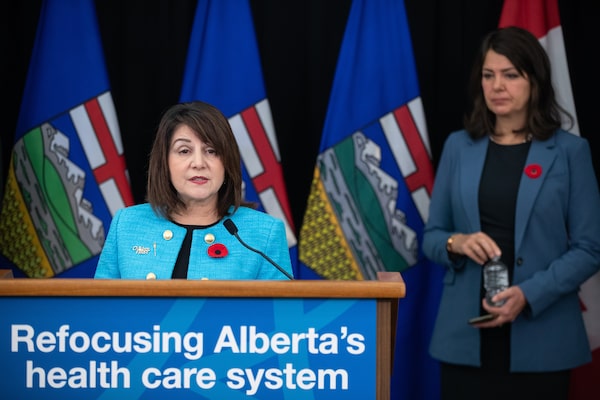
Adriana LaGrange, Alberta minister of health, speaks about health-care reforms as Alberta Premier Danielle Smith looks on during a news conference in Edmonton on Nov. 8, 2023.JASON FRANSON/The Canadian Press
Discussions over how to fund family medicine and stabilize acute care in Alberta have failed to produce deals because the provincial government ignored doctors’ concerns over the state of the crumbling health care system, according to the outgoing president of the Alberta Medical Association.
Paul Parks, an emergency department physician who will deliver his farewell remarks to his fellow medical professionals Friday at a conference, in an interview said the system-wide strain is exacerbated by Premier Danielle Smith’s effort to tear apart Alberta Health Services and replace it with four new organizations. This refocusing effort, he said, is injecting “chaos” into Alberta’s battered health care system.
Dr. Parks said he spent his year-long term as AMA president trying to work collaboratively with government to produce a new model to fund family medicine, and secure stability in acute care. Alberta, in April, said it worked with the AMA to develop a new compensation structure for family doctors and rural generalists, but a firm deal has yet to materialize. Dr. Parks said collaborating with government did not work and he can no longer beg colleagues to be patient.
“It failed,” he said. “Government is choosing not to act.”
Without the prospect of a deal, Dr. Parks said, Alberta’s family doctors are increasingly likely to consider switching to more lucrative areas of medicine or leaving the province for better offers.
The government and the AMA agreed that creating a new funding model for family medicine and stabilizing acute care were key priorities, Dr. Parks said. But Ms. Smith, who secured office in part because of her distrust of medical expertise tied to COVID-19, had a third goal: to break up AHS.
That work is making the situation worse, Dr. Parks said.
“They are spending an inordinate amount of their energy disintegrating the system, adding chaos and making it harder for us to do our job,” he said.
Negotiations with the province will fall to AMA president-elect Shelley Duggan next month.
Alberta earlier this month began operations at Recovery Alberta, the first of its four new health care organizations. Recovery Alberta is focused on treating mental illness and addictions.
Jessi Rampton, a spokeswoman for the Health Ministry, did not acknowledge a message seeking an interview with Health Minister Adriana LaGrange.
Ms. LaGrange, in a statement issued Thursday morning, thanked Dr. Parks for working with her and getting the AMA and government “so close to finalization” on a compensation model for primary care physicians.
“We knew from the start that developing a new physician compensation model would be a complex and time-consuming process,” she said in the statement. “This work was never about quick fixes, and there is still a little more work to be done.”
The government is also negotiating with the union representing nurses. The United Nurses of Alberta, in an update last week, said the final three days of informal mediation were scheduled for Sept. 17-19.
Alberta’s population is expected to grow to 4.9 million in 2024, up 4.6 per cent from the year prior. This record growth spurt is putting pressure on the province’s services and finances. At the end of August, Finance Minister Nate Horner indicated the government may dip into its contingency fund to cover unanticipated expenses in health.
Ms. Smith, on Tuesday, earmarked $8.6-billion over the next seven years to build schools to help the education system manage the crush of new students.
Kelly Cryderman: Danielle Smith promises billions for schools. Where will it come from?
The relationship between doctors and the Alberta government has been teetering since February, 2020, when Tyler Shandro, who served as health minister under former premier Jason Kenney, ripped up the province’s compensation agreement with physicians.
Ms. LaGrange, last December, announced bridge funding for family doctors, while discussions over a new deal continued. Dr. Parks noted that the $157-million earmarked for 2024 was comprised of $57-million in previously announced funding and $100-million from the federal government. He also noted the acute care side was left with no new money.
Dr. Parks said the AMA proposed a pay structure for family medicine that would cost government about $200-million to $250-million a year as Alberta moves away from the fee-for-service model. He noted discussions are about funding businesses – which require office space, employees and equipment – rather than just paying family physicians.